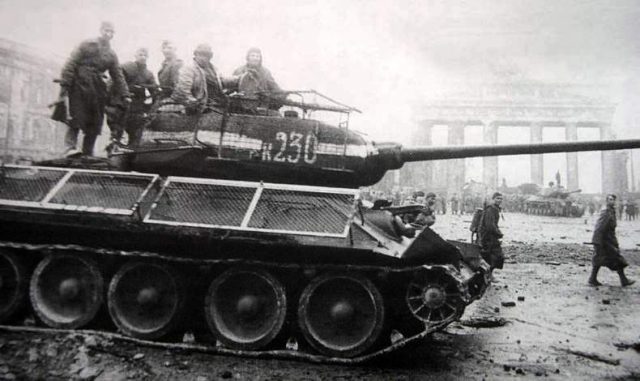
T-34-85 with grid-frame protections (aka the T34-85E 'Ekrani', 'with screens'), Berlin, Brandenburg gate, May 1945
Posted on 03/07/2021 10:59:55 PM PST by L.A.Justice
Over ten days in the spring of 1945, Army Engineers expedited the invasion of Germany and thus shortened the Second World War in Europe by daringly capturing one of the last bridges left standing across the River Rhine. It had been nine months since D-Day, and Allied forces had fought in several long, difficult campaigns across France and the highlands of the Ardennes forest and had just crossed the German border. The last natural barrier to driving deeper into German territory was the Rhine. Starting in March, Operation Lumberjack, led by the U.S. First Army, aimed to secure the west bank of the river and prepare for a massive crossing to be led by the British. In order to undermine German supply lines to the front, the Allies had systematically bombed bridges up and down the river for months, so the discovery of an intact WWI-era bridge across the Rhine at the town of Remagen (about 14 miles south of Bonn) was a big surprise.
Brig. Gen. William M. Hoge, an engineer soldier, was in charge of Combat Command B, 9th Armored Division, when its leading elements discovered the Ludendorff rail bridge still standing at Remagen. “I got up to the Rhine and stood there on the bank and looked down, and there it was,” Hoge recalled. “The bridge was there right above the town. I couldn’t believe it was true. I issued an order right away to go down and grab that bridge, go down through the town and put tanks on both sides of the bridge, firing parallel to it.” The risk was exceptional—what if the Germans destroyed the bridge while Hoge’s forces were crossing it or even allowed some to cross before cutting off their retreat?
(Excerpt) Read more at usace.army.mil ...
Thanks for sharing!
I watched a documentary on this where is showed young German boys with Panzerfausts (anti-tank weapons); the Soviets were terrified of them, as they’d hide and blast the tanks from the rear. They were uniformed, but of course the uniforms and helmets were far too big. The boys described it as “cracking tanks”...

T-34-85 with grid-frame protections (aka the T34-85E 'Ekrani', 'with screens'), Berlin, Brandenburg gate, May 1945
The Germans started running out of young teens as well; a lot of them were killed in the battle.
Amazing how they improvised that screen; I’ve seen similar ones on light armored vehicles today (I believe to detonate RPGs before they hit the hull itself). In the movie “Fury”, the US tanks had logs on the sides. In real life, I believe some would mount the extra tread sections kept for repairs around the turret/on the sides.
Well, yes. Ivan just started shooting youths first and asking stupid questions later. It had the intended effect.
Fury was not very historically accurate. Using stored extra tracks as potential armor improvements wasn’t just something done in the field, many tanks came with (and still do come with) conveniently placed track link storage brackets.
The smaller German tanks had spaced armor panels developed earlier in the war, similar in concept though for different reasons. (The Germans in Panzer 38Ts, IIIs and IVs learned to *really* hate Russian antitank rifles.)
Related viewing:
https://www.youtube.com/watch?v=yaLyAjAjoDM
FYI: A lot of WW2 records are finally being declassified around the world and we are finding out that a lot of what we ‘knew’ about weapons may not actually be so - such as the fact that the stats show that the Sherman was statistically one of the safest tanks of the war, even before the ammo was put in wet stowage.
Oh, I understand the kids were combatants - no problem there.
Disclaimer: Opinions posted on Free Republic are those of the individual posters and do not necessarily represent the opinion of Free Republic or its management. All materials posted herein are protected by copyright law and the exemption for fair use of copyrighted works.